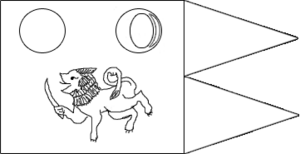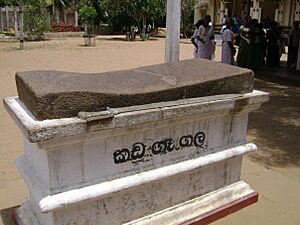Battle of Vijithapura facts for kids
The Battle of Vijithapura was a very important fight in ancient Sri Lanka. It happened during a big campaign led by King Dutthagamani against King Ellalan, who had invaded from South India. This battle is written about in old Sri Lankan history books, called chronicles. These books mostly tell the story from Dutthagamani's side, so we don't know much about Ellalan's army.
Dutthagamani's army had been taking back control of different areas from Ellalan. They then reached the strong city of Vijithapura. There was a long fight, a siege that lasted four months! After that, Dutthagamani's special warriors, known as the Ten Giant Warriors, and his royal elephant played a huge part in a final attack. The battle was a big win for Dutthagamani. It made Ellalan's army much weaker, which eventually led to Dutthagamani defeating and killing Ellalan. Even today, people in Sri Lanka remember this battle as a legendary event.
Quick facts for kids Battle of Vijithapura |
|||||||||
|---|---|---|---|---|---|---|---|---|---|
| Part of Dutthagamani's campaign against Ellalan | |||||||||
|
|||||||||
| Belligerents | |||||||||
| Duttagamini principality | Chola Dynasty | ||||||||
| Commanders and leaders | |||||||||
| Dutthagamani | Ellalan † | ||||||||
| Units involved | |||||||||
|
Army of Dutthagamani
|
Chola Army | ||||||||
| Strength | |||||||||
| Unknown | Unknown | ||||||||
| Casualties and losses | |||||||||
| Heavy losses | Heavy losses | ||||||||
Contents
How We Know About the Battle
The story of Dutthagamani's fight against Ellalan is told in great detail in old Sri Lankan books. These include the Mahavamsa, Dipavamsa, Rajavaliya, and Thupavamsa. All these books describe the Battle of Vijithapura as a very important event.
Dutthagamani is shown as a great hero in these stories. His campaign is often called a "holy war" to bring back Buddhism to the country. Because of this, the stories are very positive about him. The descriptions of the Battle of Vijithapura mix real facts with some legendary parts. However, historians generally agree that the main events described in these books are true. Since the stories are mostly from one side, we don't have much information about Ellalan and his army.
Why the Battle Happened
At the time of the battle, Ellalan was the king of Anuradhapura. He was a prince from the Chola Dynasty in South India. He had taken over the country after defeating the previous Sinhalese ruler, Asela. Even though he was an invader, Ellalan was known as a fair ruler. He even supported Buddhism.
Most of the country was under Ellalan's rule. But in the south, a Sinhalese king named Kavan Tissa was organizing a resistance. His kingdom was called Ruhunu. After Kavan Tissa died, his son, Dutthagamani, became king.
Soon after becoming king, Dutthagamani started his campaign against Ellalan. His goal was to "restore and glorify Buddhism" in Sri Lanka. He began his journey from Magama and crossed the Mahaweli river. Along the way, Dutthagamani captured many forts and cities that belonged to Ellalan. He also defeated several of Ellalan's generals. The old books call all these defeated leaders Demalas (Tamils). However, it's possible that not all of them were Tamils. One general, named Dighabaya, might have even been Dutthagamani's own stepbrother who later joined Ellalan.
The City of Vijithapura
After winning these battles, Dutthagamani's army marched towards the "great fortress of Vijithapura". Dutthagamani used a road between Sigiriya and Minneriya to get his army there. This road had been used by an earlier ruler, Pandukabhaya, for his military campaigns too.
The city of Vijithapura was also called Vijitha Nagara in the Mahavamsa. It was built almost 300 years before this battle. By the time of the battle, it had become a very strong fort for Ellalan. It was said to have three moats (ditches filled with water) around it. It also had a tall wall, about 18 cubits high (a cubit is an old measure, roughly from elbow to fingertip). This wall had four strong iron gates on the north, south, east, and west sides. The Rajavaliya book says that Vijithapura was the second strongest fortress after Anuradhapura.
Controlling Vijithapura was very important for both sides. If Ellalan lost it, his army would feel very discouraged. It would also make it much harder for them to stop Dutthagamani. For Dutthagamani's army, capturing Vijithapura meant they could easily move on to attack Anuradhapura.
The Siege of Vijithapura
Any of Ellalan's soldiers who had survived earlier battles went back to Vijithapura, making its defenses even stronger. Dutthagamani's army arrived and set up their camp near the fortress. This open area where they camped later became known as Khandavara Pitthi or Kandavurupitiya.
Dutthagamani's army regularly attacked the fortress. The defenders inside also made occasional quick attacks, called sorties, outside the walls. But for four months, neither side could win. After this long siege, Dutthagamani planned a huge attack using his entire army. His army was led by his ten best warriors, known as the "Ten Giant Warriors". They were going to play a very important role in the battle.
Testing the Warriors
The old chronicles mention two tests Dutthagamani did to check his warriors' skills before the battle. For the first test, Dutthagamani asked them to drink a large pot of toddy (a type of palm wine). He wanted to see how strong they were. All the warriors refused except for Suranimala, who stepped forward and drank the whole pot easily.
The second test was for Nandimithra, who was the commander of the army. Dutthagamani made his royal elephant, Kandula, very angry and sent it towards Nandimithra. But Nandimithra stood firm. He grabbed the elephant by its tusks and pushed it to the ground!
After seeing how skilled and brave his warriors were, Dutthagamani ordered the war drums to be beaten. He raised his flags and began the big attack to capture Vijithapura.
The Final Attack
Dutthagamani's army attacked all four gates of the city at the same time. Dutthagamani himself led the main attack on the southern gate with Nandimithra, Suranimala, and the elephant Kandula. The attacks on the northern and western gates were led by Bharana, Khanjadeva, Phussadeva, and Labhiyavasabha. The eastern gate was attacked by Mahasona, Gothaimbara, Theraputthabhaya, and Velusumana. Velusumana's cavalry (soldiers on horseback) quickly defeated the defenders of the eastern gate, and Ellalan's forces went back inside the city.
Ellalan's archers shot arrows from the walls, causing many injuries to Dutthagamani's attackers. Soldiers on top of the walls also poured hot, melted metal down on them to stop them from breaking through. The elephant Kandula, trying to break the southern gate, was hurt by this attack. After his injuries were treated and he was protected with thick animal hides, Dutthagamani encouraged Kandula. The elephant then charged against the wall again. This time, the wall broke, and Dutthagamani's army rushed into the city.
The ten champions, not wanting to use the opening made by the elephant, broke through the wall themselves in different places and entered the city. Led by these brave warriors, Dutthagamani's army defeated the defenders and took control of the fortress city of Vijithapura. The soldiers who survived retreated to Anuradhapura.
What Happened Next
Capturing Vijithapura cleared the way for Dutthagamani's army to move towards Anuradhapura. They went there right away, taking two more of Ellalan's strongholds on their way. In the battle for Anuradhapura, Dutthagamani fought Ellalan in a one-on-one combat and killed him. Dutthagamani then became the king of Anuradhapura, bringing the entire country under his rule.
The Battle Today
The Battle of Vijithapura is a famous and legendary battle in Sri Lankan history. It was a very important step in Dutthagamani's campaign to bring back Buddhism to the country. People often call it Vijithapura maha satana, which means "the great battle of Vijithapura". After the Sri Lankan Civil War ended in 2009, General Sarath Fonseka, who was the commander of the Sri Lanka Army, compared some of their battles to the Battle of Vijithapura.
The exact place where the Vijithapura fortress stood is not known for sure. There is a village with the same name near the old Kalawewa reservoir. This might be where the battle took place. There is an old temple there, and a granite stone that local people believe Dutthagamani's soldiers used to sharpen their swords. However, other historians and archaeologists think the location is near Kaduruwela, close to Polonnaruwa. Ruins of an ancient fortress have been found there.
See also
- Ten Giant Warriors



